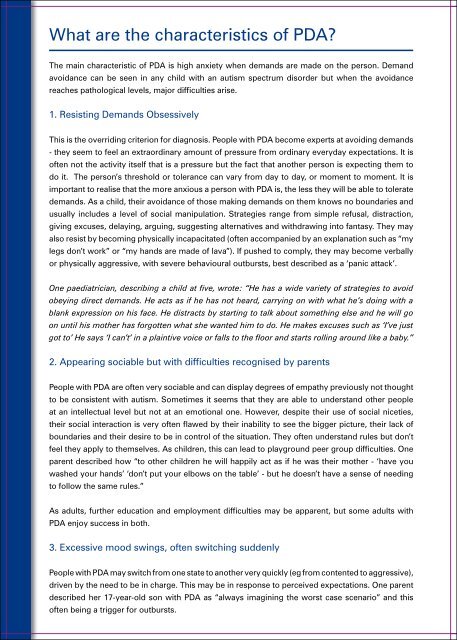PDA_Booklet
PDA_Booklet
PDA_Booklet
You also want an ePaper? Increase the reach of your titles
YUMPU automatically turns print PDFs into web optimized ePapers that Google loves.
What are the characteristics of <strong>PDA</strong>?<br />
The main characteristic of <strong>PDA</strong> is high anxiety when demands are made on the person. Demand<br />
avoidance can be seen in any child with an autism spectrum disorder but when the avoidance<br />
reaches pathological levels, major difficulties arise.<br />
1. Resisting Demands Obsessively<br />
This is the overriding criterion for diagnosis. People with <strong>PDA</strong> become experts at avoiding demands<br />
- they seem to feel an extraordinary amount of pressure from ordinary everyday expectations. It is<br />
often not the activity itself that is a pressure but the fact that another person is expecting them to<br />
do it. The person’s threshold or tolerance can vary from day to day, or moment to moment. It is<br />
important to realise that the more anxious a person with <strong>PDA</strong> is, the less they will be able to tolerate<br />
demands. As a child, their avoidance of those making demands on them knows no boundaries and<br />
usually includes a level of social manipulation. Strategies range from simple refusal, distraction,<br />
giving excuses, delaying, arguing, suggesting alternatives and withdrawing into fantasy. They may<br />
also resist by becoming physically incapacitated (often accompanied by an explanation such as “my<br />
legs don’t work” or “my hands are made of lava”). If pushed to comply, they may become verbally<br />
or physically aggressive, with severe behavioural outbursts, best described as a ‘panic attack’.<br />
One paediatrician, describing a child at five, wrote: “He has a wide variety of strategies to avoid<br />
obeying direct demands. He acts as if he has not heard, carrying on with what he’s doing with a<br />
blank expression on his face. He distracts by starting to talk about something else and he will go<br />
on until his mother has forgotten what she wanted him to do. He makes excuses such as ‘I’ve just<br />
got to’ He says ‘I can’t’ in a plaintive voice or falls to the floor and starts rolling around like a baby.”<br />
2. Appearing sociable but with difficulties recognised by parents<br />
People with <strong>PDA</strong> are often very sociable and can display degrees of empathy previously not thought<br />
to be consistent with autism. Sometimes it seems that they are able to understand other people<br />
at an intellectual level but not at an emotional one. However, despite their use of social niceties,<br />
their social interaction is very often flawed by their inability to see the bigger picture, their lack of<br />
boundaries and their desire to be in control of the situation. They often understand rules but don’t<br />
feel they apply to themselves. As children, this can lead to playground peer group difficulties. One<br />
parent described how “to other children he will happily act as if he was their mother - ‘have you<br />
washed your hands’ ‘don’t put your elbows on the table’ - but he doesn’t have a sense of needing<br />
to follow the same rules.”<br />
As adults, further education and employment difficulties may be apparent, but some adults with<br />
<strong>PDA</strong> enjoy success in both.<br />
3. Excessive mood swings, often switching suddenly<br />
People with <strong>PDA</strong> may switch from one state to another very quickly (eg from contented to aggressive),<br />
driven by the need to be in charge. This may be in response to perceived expectations. One parent<br />
described her 17-year-old son with <strong>PDA</strong> as “always imagining the worst case scenario” and this<br />
often being a trigger for outbursts.


